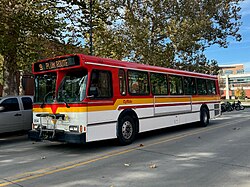|
Orion V
The Orion V was a line of rigid high-floor transit buses available in 32', 35', and 40' lengths manufactured by Ontario Bus Industries (renamed Orion Bus Industries in 1995) between 1989 and 2009. The conventionally powered buses, either with longitudinally mounted diesel or natural gas engines, used a T-drive transmission coupling. The Orion V replaced the Orion I, and was in turn replaced by the low-floor Orion VI (introduced in 1993) and Orion VII (introduced in 2001). Design The two-piece windshield of the Orion V has the driver's windshield canted towards the back of the bus to reduce reflections. The bus was available in both transit (two-door) and suburban (single front door) configurations.[2] The Orion V uses a welded monocoque steel tube frame clad with steel and fiberglass panels, and an aluminum roof.[3]: 8 [4]: 7 [5]: 6 The interior floor height is 35.75 inches (908 mm) except for the vestibule portion starting at the rear wheels, which is slightly lower at 34.5 inches (880 mm). The first step height is 14.5 inches (370 mm) for the front (11 inches (280 mm) when knelt) and 15.75 inches (400 mm) for the rear.[2] All buses, regardless of fuel type, use longitudinally mounted engines with a T-drive transmission coupling driving the rear axle. Compressed natural gas (CNG) buses carry their fuel on the roof in eight tanks, with a collective volume of 10,440 cu ft (296 m3) at a pressure of 3,000 psi (21,000 kPa), measured at 70 °F (21 °C).[3]: 9 Diesel buses were offered with 96, 125, or 150 US gal (360, 470, or 570 L) fuel tanks.[1] Ontario (later Orion) Bus Industries (OBI) marketed the Orion V to both the Canadian and United States transit markets. Canadian buses were assembled at the OBI plant in Mississauga, Ontario. For the US market, to meet 'Buy America' requirements for federally subsidized transit vehicles, the Orion V was assembled by wholly owned subsidiary Bus Industries of America (BIA) in Oriskany, New York. ModelsInternally, OBI designated the bus model as 05.50x, with x designating the model number.[3]: 7 [4]: 7
Hybrid prototypesA series hybrid bus was developed by the New York State Consortium using an Orion V 40' chassis equipped with powertrain components supplied by General Electric. This hybrid bus prototype used tandem rear axles driven by four traction motors, one for each wheel. Electric traction power was generated by a Cummins B5.9 diesel engine rated at 190 hp (140 kW) driving a 100 kW (130 hp) alternator, and energy from regenerative braking was stored in nickel-cadmium batteries.[7] DeploymentThe Orion V was OBI's most popular transit bus.[8] The first production bus was sold to Mississauga Transit.[9] Major transit agency users included New York City (MTA), Toronto (TTC), and Washington, D.C. (WMATA). For MTA, some buses in the final order from 1999[10] were unreliable and plagued with significant structural corrosion.[11] Coast Mountain Bus Company in Vancouver operates the Orion V Suburban models built in 2008, the last buses built for a Canadian agency. The last Orion V models were built for Sonoma County Transit in 2008. TTC retired its Orion V fleet in December 2015; the retirement event featured a final 40-minute ride on No. 9411.[12] As of 2025, a handful of Orion V models remain in operation such as Beaver Bus Lines of Brandon, Manitoba, which currently operates a number of former GO Transit buses built from 2000 to 2004 and Coast Mountain Bus Company in Vancouver that also runs the suburban Orion V models built in 2008, as the last Orion V buses manufactured for a Canadian transit system. With Everett Transit retiring their remaining 2001/2002 Orion V buses in December 2024, that leaves the Bee-Line Bus System, CyRide and Sonoma County Transit as the last operators of the Orion V buses in diesel and CNG configurations in the US. CompetitionReferences
External linksWikimedia Commons has media related to Orion V.
Information related to Orion V |
||||||||||||||||||||||||||||||||||||||||||||||||||||||||||||||||||||


